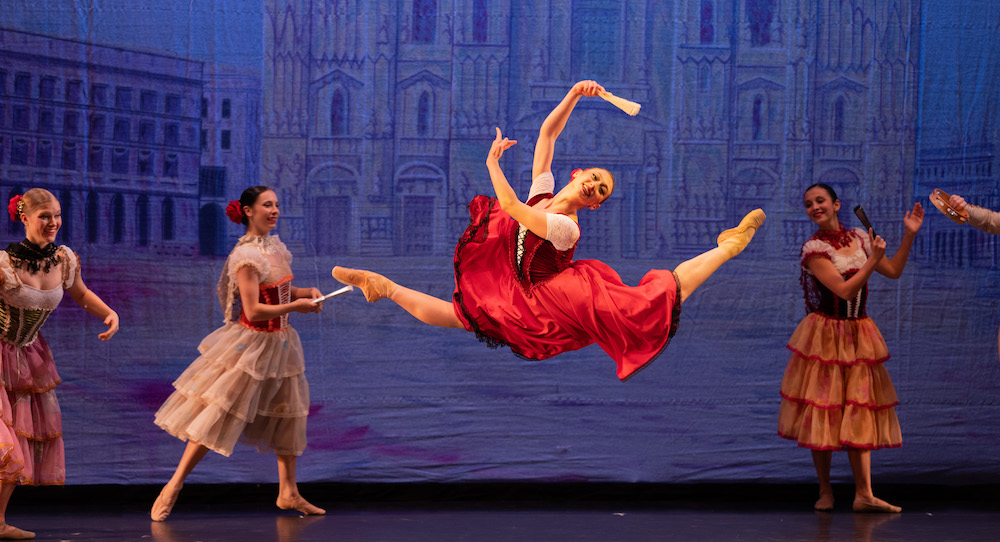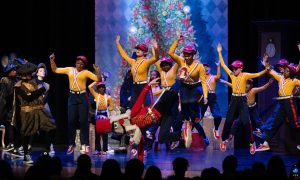The Woodman Family Community and Performance Center, Providence, RI.
November 1, 2024.
The gentle slope of a fruit in a still life, a mind-blowing idea in a nonfiction text, the pathos of a character in a classic novel, the way light and shadow dance on a spring day: any of it can be fodder for kinetic inspiration. Art is all around us, and so is movement.
Art & Literature Meet Ballet, the Opener for Ballet RI’s 2024-2025 Season, underscored how inspiration for dance art can come from anywhere – and, arguably, especially from the fruits of other art forms. The program’s works drew upon sculpture, poetry, an opera and a novella. From there, they became unique and valuable works in their own right…who knows, perhaps inspiring yet further artists to create something of their own.
The program kicked off with Leonid Yakobson’s enticing and soulful Rodin (staged in consultation with the Leonid Yakobson Foundation). The work brought three classic Rodin structures – The Kiss (1882), Eternal Spring (1907) and Eternal Idol (1889) – to moving life.
Each of those sculptures had their own section, including three separate man/woman pairs. Each embodied one of the sculptures, having their own sense of movement and drama: from the quality of the embrace (or almost-embrace), the direction of gaze, the figures’ weightedness in clay.
Design elements of nude-hued costumes and bright, yet soft lighting stayed consistent – yet, through clear emotional delivery and keen movement vocabulary, the atmosphere shifted with each section. All three sections felt like they could be their own shorter works, complete in and of themselves.
At the same time, the piece opened and closed with the three duet pairs all together, moving independently from each other and then taking beautifully (and appropriately) statuesque poses. That structural choice brought it all into one digestible, and quite satisfying, package.
Also notable to me was how Yakobson’s movement vocabulary (across the work as a whole: the opening, three sections, and closing) wasn’t notably athletic – at least as compared with the works in the program to come. That quality of movement seemed to serve the work, to echo the gravitas and vulnerable humanity evident in all three sculptures of inspiration.
Helen Pickett’s tenacious duet When Love took the stage next. The cross-disciplinary inspiration for this work was Philip Glass’s opera Einstein on the Beach (1976). Dancing the lightning-quick and explosively expansive movement, dancers Styles Dykes and Heather Nichols stepped right up to the exciting precipice where one loses control.
Matching the speed and energy of the score, as well as the fiery colors in lighting (by Mark Stanley) and costuming (by Charles Heightchew), they peered right over the edge into frenetic chaos. Yet they also found grounding in their own strength, and – quite meaningfully – in each other.
Nichols leaned into a gracefully spiraled backbend as she turned with Dykes’ support. “I have you, feel free to fly,” his presence and bearing communicated. Softening into that support, while remaining supported in her own physicality, she took him up on that offer.
Rippling spines and sending energy out from every limb, fully filling the stage with just the two of them, they both found that embodied freedom. In art, in life, driven by various means of inspiration and generative fuel, that precipice where we gain footing before the fall can be the most thrilling place of all.
Yury Yanowsky’s Beekeeper came next. Yanowsky drew upon Charles Tomlinson’s poem If Bach Had Been a Beekeeper (1976). The work brought Yanowsky’s signature kinetic perceptiveness, which always delivers a pleasing meeting of technical precision and audacious exploration, to a unique concept.
It’s unclear as to what extent, and in what ways, Yanowsky intended for the work to convey the dynamics within a bee colony (unlike with many Ballet RI programs, there wasn’t a short video in each work to offer context around the work’s process…an approach with both advantages and disadvantages). Yet, I could see many of those dynamics at work.
Like bees, the performers felt like autonomous agents nevertheless intimately connected with the whole. The stark design – of dim lighting (also by Mark Stanley), black costumes, and a bare backdrop – supported a feeling of uniformity in the group, and also allowed the movement to be the visual “wow” at hand. Circular shapes reflected beehives, with clean lines juxtaposing those shapes.
The geometric layers at hand were many and multifaceted, yet – just like an elegantly arranged beehive – remained pleasantly distinct. Impressively, staging also offered that clarity, such as with (towards the end of the work) several dancers turning in an arabesque while their supporting partners held a circular shape.
After the work, during intermission, a friend attending the program with me shared that she recently learned about bee colony behaviors – and how she saw some of those reflected in the work. That made me want to learn more about those behaviors and the fascinating social structure within which bees live. There are so many things to explore and from which to receive inspiration, in and from places we may very well not expect, I then thought. I smiled to myself at the bright thought.
Yanowsky’s reimagining of Don Quixote Suite topped off the program, bursting with vibrancy and joy. The art and literature connection: Miguel Cervantes’ novel inspired the 1869 Petipa ballet. The act reminded me that there’s always a place for classical elegance and beauty – especially, one could argue, in times of turbulence and uncertainty. The ensemble demonstrated their theatrical chops through myriad little moments of delightful drama: of jealousy, of desire, of humor, of care, of community.
Rhythm and musicality were prominent through it all, from smooth integration of instruments into movement to lively group chants. Those choices felt like a wonderful depiction, and acknowledgement, of the centrality of music (and how it comes together with movement) within Hispanic/Latin culture.
Costuming (from LeGrand) was also notable, with elements like fishnet sleeves adding subtle modernized touches. Ballet RI (and previously as Festival Ballet Providence) has always been intentional about both preserving the art form’s tradition and pushing it forward into a brighter future – so that only felt par for the course.
It did occur to me what I’ve thought about this company before: they are strong in both classical and contemporary work, but truly shine in the latter. I’m grateful that they consistently program both, continuously offering that preservation and innovation. In whatever mode, from whatever inspiration, we can honor and appreciate it all. We never know what can inspire us, and what can result when we follow the path down which that inspiration leads. Thank you to Ballet RI for that meaningful reminder!
By Kathryn Boland of Dance Informa.















